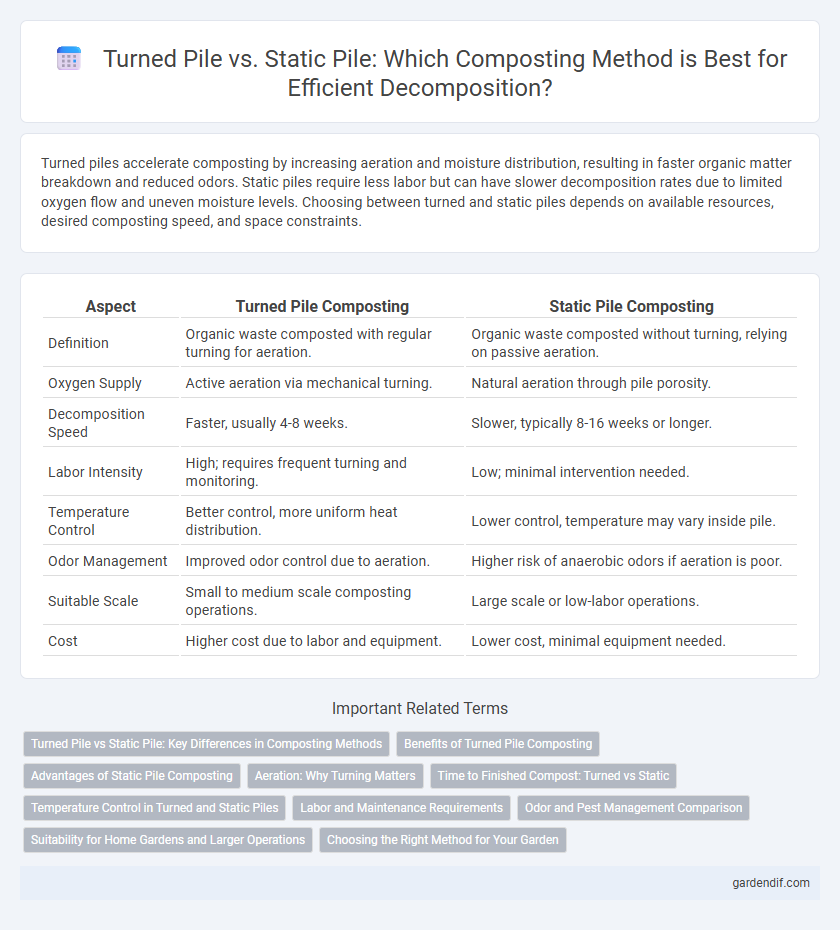
Turned Pile vs Static Pile Illustration
Turned piles accelerate composting by increasing aeration and moisture distribution, resulting in faster organic matter breakdown and reduced odors. Static piles require less labor but can have slower decomposition rates due to limited oxygen flow and uneven moisture levels. Choosing between turned and static piles depends on available resources, desired composting speed, and space constraints.
Table of Comparison
| Aspect | Turned Pile Composting | Static Pile Composting |
|---|---|---|
| Definition | Organic waste composted with regular turning for aeration. | Organic waste composted without turning, relying on passive aeration. |
| Oxygen Supply | Active aeration via mechanical turning. | Natural aeration through pile porosity. |
| Decomposition Speed | Faster, usually 4-8 weeks. | Slower, typically 8-16 weeks or longer. |
| Labor Intensity | High; requires frequent turning and monitoring. | Low; minimal intervention needed. |
| Temperature Control | Better control, more uniform heat distribution. | Lower control, temperature may vary inside pile. |
| Odor Management | Improved odor control due to aeration. | Higher risk of anaerobic odors if aeration is poor. |
| Suitable Scale | Small to medium scale composting operations. | Large scale or low-labor operations. |
| Cost | Higher cost due to labor and equipment. | Lower cost, minimal equipment needed. |
Turned Pile vs Static Pile: Key Differences in Composting Methods
Turned piles require regular aeration by physically mixing the compost to enhance microbial activity and accelerate decomposition, while static piles rely on passive aeration with limited oxygen flow, leading to slower breakdown. Turned pile composting typically produces finished compost faster and with more uniform temperature distribution, reducing odor and pathogen risks compared to static piles. Static piles are often less labor-intensive and suitable for large-scale or low-maintenance operations but may result in uneven compost quality and longer processing times.
Benefits of Turned Pile Composting
Turned pile composting enhances aeration and accelerates microbial activity, resulting in faster decomposition and higher-quality compost. Regular turning prevents anaerobic conditions, reducing odor and pathogen risks while maintaining optimal temperature and moisture levels. This method promotes uniform nutrient distribution, producing nutrient-rich organic matter ideal for soil amendment and plant growth.
Advantages of Static Pile Composting
Static pile composting conserves moisture and reduces labor costs by eliminating the need for frequent turning, making it energy-efficient and cost-effective for large-scale organic waste management. This method promotes the growth of thermophilic microorganisms in stable temperature zones, enhancing pathogen reduction and odor control. Static piles also support continuous composting with minimal disturbance, preserving the microbial ecosystem essential for high-quality humus production.
Aeration: Why Turning Matters
Turned compost piles improve aeration by intermittently exposing different layers to oxygen, accelerating microbial activity essential for organic matter breakdown. Static piles rely on passive aeration, often resulting in anaerobic zones that slow decomposition and create unpleasant odors. Proper turning maintains oxygen levels, ensuring efficient composting and higher-quality end product.
Time to Finished Compost: Turned vs Static
Turned compost piles typically reach finished compost faster, often within 4 to 8 weeks, due to improved aeration and accelerated microbial activity. Static piles may take 3 to 6 months as limited oxygen slows the decomposition process. Efficient moisture and temperature management in turned piles enhances pathogen destruction and nutrient stabilization, shortening the composting timeline.
Temperature Control in Turned and Static Piles
Temperature control in turned compost piles is more efficient due to regular aeration, which promotes uniform microbial activity and prevents overheating or anaerobic conditions. Static piles rely on passive aeration, often resulting in uneven temperature distribution with potential cold spots that slow decomposition. Optimal temperature management in turned piles accelerates organic matter breakdown and reduces pathogen survival compared to static pile methods.
Labor and Maintenance Requirements
Turned piles require more labor and frequent manual or mechanical agitation to maintain aerobic conditions, ensuring faster decomposition and odor control. Static piles have lower labor demands due to minimal turning but need careful management of moisture and aeration to prevent anaerobic pockets and slow composting. Proper selection between these methods depends on the available workforce and maintenance capacity to sustain efficient composting processes.
Odor and Pest Management Comparison
Turned piles enhance aeration by regularly mixing compost, which accelerates microbial activity and significantly reduces odor and pest issues compared to static piles. Static piles, lacking frequent agitation, often create anaerobic zones that produce foul odors and attract pests such as flies and rodents. Effective odor and pest management in composting heavily relies on maintaining aerobic conditions, making turned piles the superior method for mitigating these problems.
Suitability for Home Gardens and Larger Operations
Turned piles offer enhanced aeration and faster decomposition, making them ideal for larger operations requiring efficient bulk processing. Static piles, with minimal maintenance and lower labor demands, suit home gardens where smaller quantities of compost are produced. Choosing between turned and static piles depends on compost volume, available space, and time investment.
Choosing the Right Method for Your Garden
Turned piles promote faster decomposition by providing aeration and mixing organic materials, making them ideal for gardeners seeking quicker compost production. Static piles require less labor and retain moisture better, suitable for low-maintenance gardens with ample space. Selecting the right method depends on your garden's size, time commitment, and desired composting speed.
Turned Pile vs Static Pile Infographic

 gardendif.com
gardendif.com